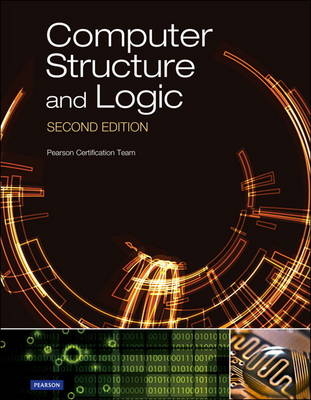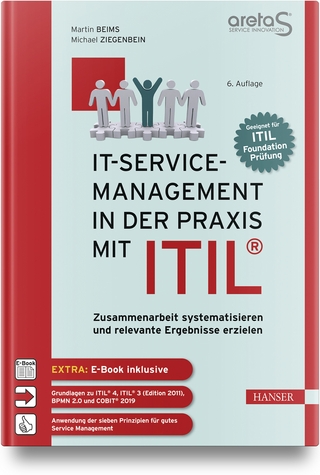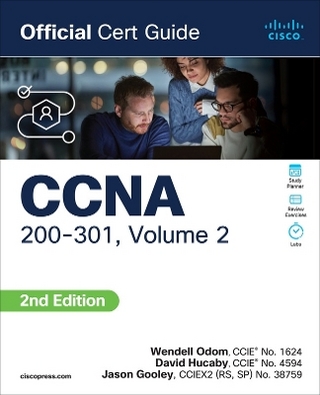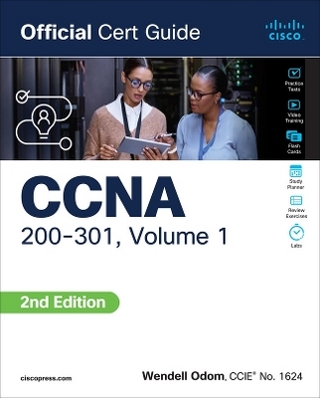
Computer Structure and Logic
Pearson IT Certification (Verlag)
978-0-7897-5184-3 (ISBN)
- Titel ist leider vergriffen;
keine Neuauflage - Artikel merken
Computer Structure and Logic, Second Edition gives you a complete overview of modern computer technology, from desktop and laptop PCs to mobile devices, hardware to operating systems, basic security to networking. Requiring no previous knowledge of computers, this textbook helps you build your knowledge and hands-on skills one easy step at a time.
The book starts by reviewing the history of computing and explaining what nearly all modern computers have in common, whether they are immensely powerful supercomputers, personal computers, or even smartphones. Next, it explains how computers process information, how hardware components are brought together in a working computer, and what happens “behind the scenes” when you turn on a computer.
Building on this essential hardware knowledge, the book then turns to software. You learn how modern operating systems, such as Windows, Linux, and Android, work and how operating systems are organized, configured, and managed. You then learn how computers can be connected into networks such as the Internet, and how networked computers communicate using shared protocols such as TCP/IP.
Computer Structure and Logic introduces modern innovations that are reshaping computing for both businesses and individuals, including virtual and cloud computing. Next, it introduces the basics of computer and network security, showing how to protect computers, information, and services from unwanted intrusion, unauthorized access, and/or the modification or destruction of data. The text concludes with a full chapter on troubleshooting, including a complete six-step process for identifying and solving computer problems of all kinds.
Full of real-world practical examples, Computer Structure and Logic, Second Edition gives you foundational knowledge and skills for starting your career in information technology, and for taking your first steps toward official certification from leading organizations such as CompTIA, Microsoft, and Cisco.
Powerful features make learning about computers easier!
--Clear introductions describe the big ideas and show how they fit with what you’ve already learned
--Specific chapter objectives tell you exactly what you need to learn
--Key terms lists help you identify important terms, and a complete glossary helps you understand them
--Glossary defines more than 250 essential computing terms
--Notes point out important transitions, key connections to other topics, items that might otherwise be lost in the detail, and real-world application of the topic at hand
--Chapter Review Activities call on you to define key terms, answer review questions, and work through case studies to help you make sure you’ve learned the material
Coverage includes
--Basic computer concepts
--Computer math, measurement, and processing
--Motherboards and buses
--CPUs
--Memory and storage
--I/O devices and ports
--Operating a computer
--Operating systems: characteristics and interfaces
--Operating systems: architecture, configuration, and management
--Networks
--Virtualization and cloud computing
--Basic security
--Computer troubleshooting
Introduction
Chapter 1 Introduction to Computers
Chapter Outline
Objectives
History of Computers
The von Neumann Computer Model
Modern Computers
From Tubes to Transistors
Integrated Circuits
History of the PC
Birth of the Personal Computer
The IBM Personal Computer
The PC Industry Today
What Is a PC?
Who Controls PC Software?
Who Controls PC Hardware?
White-Box Systems
PC Design Guides
System Components
What Is a Mobile Computer?
Mobile Computer Hardware
Differences and Similarities Between Tablets and Laptops
Mobile Computer Software
Chapter Summary
Chapter Review Activities
Define the Key Terms for Chapter 1
Answer These Questions and Case Studies
Answers, Explanations, and Solutions
Chapter 2 Understanding Computer Math, Measurement, and Processing
Chapter Outline
Objectives
CompTIA A+ Objectives Covered
Numbering Systems Used in Computers
Decimal Numbering System
Binary Numbering System
Converting Decimal Numbers to Binary
Hexadecimal Numbering System
Basic Boolean Operations
AND
OR
NOT
Mixed Boolean Operations
Measuring Data Transfer and Frequency
Bandwidth
Hertz (Hz)
How Computers Process Information
CPU
Working Storage
Permanent Storage
Input Devices
Output Devices
A Basic Example of Data Transfer Through the Computer
Chapter Summary
Chapter Review Activities
Define the Key Terms for Chapter 2
Answer These Questions and Case Studies
Answers, Explanations, and Solutions
Chapter 3 Motherboards and Buses
Chapter Outline
Objectives
CompTIA A+ Objectives Covered
The Evolution of Motherboards
The 286 PC–Last of the 16-Bit Computers
The 386 PC–and the 32-Bit Age
Today’s 64-Bit Computing
Other Examples of Modern Motherboards
Motherboard Components
The Core Components
The Chipset and Connecting Buses
Form Factors
I/O Ports and Front Panel Connectors
Expansion Buses
Drive Technologies
Installing Motherboards
Step-by-Step Motherboard Removal
Preparing the Motherboard for Installation (ATX)
Step-by-Step Motherboard Installation
Installing Adapter Cards
General Installation
Display Adapters
Video Capture Cards and TV Tuners
Sound Cards
Chapter Summary
Chapter Review Activities
Define the Key Terms for Chapter 3
Answer These Questions and Case Studies
Answers, Explanations, and Solutions
Chapter 4 The CPU
Chapter Outline
Objectives
CompTIA A+ Objectives Covered
The Evolution of the CPU
How the CPU Operates
Cache Memory
Registers
Storing Data to RAM and the Hard Drive
The Four Steps of Processing
How the CPU Operates–Summary
CPU Technology
Clock Rate
Hyper-Threading
Multicore Technologies
Processor Throttling
MMX and SSE
VRM
32-Bit Versus 64-Bit Revisited
Sockets
Power Consumption
Cooling
Intel and AMD Processors
Intel Processors
AMD Processors
Overview of Processor Differences
Mobile Processors
Mobile CPUs and Manufacturers
ARM CPU Processing
Choosing the Best Processor for the Job
Custom PC Configurations
Other Important CPU Considerations
Installing and Upgrading Processors
Installing a CPU
Removing Older Heat Sinks
Chapter Summary
Chapter Review Activities
Define the Key Terms for Chapter 4
Answer These Questions and Case Studies
Answers, Explanations, and Solutions
Chapter 5 Memory and Storage
Chapter Outline
Objectives
CompTIA A+ Objectives Covered
RAM Basics
RAM Types
SRAM Versus DRAM
SDRAM
DDR
DDR2
DDR3
DDR4
Laptop Memory
RDRAM (Rambus)
RAM Technologies
Single-Channel Versus Dual-Channel Versus Triple-Channel
Memory Latency
Single-Sided Versus Double-Sided
Parity Versus Nonparity
ECC Versus Non-ECC
Registered and Fully Buffered
One Final Note: Make Sure Your RAM Is Compatible!
The Synergy Between Memory and Programs
Installing DIMMs
Installing RAM to a PC
Installing RAM to a Laptop
Testing RAM Installations
Hard Drives
Hard Disk Drive Basics
SATA
PATA
Solid-State Drives
SCSI
RAID
Optical Drives
Compact Disc (CD)
Digital Versatile Disc (DVD)
Blu-ray
Solid-State Storage Media
Solid-State Drives
USB Flash Drives
Secure Digital Cards
CompactFlash Cards
Chapter Summary
Chapter Review Activities
Define the Key Terms for Chapter 5
Answer These Questions and Case Studies
Answers, Explanations, and Solutions
Chapter 6 I/O Devices and Ports
Chapter Outline
Objectives
CompTIA A+ Objectives Covered
Understanding I/O Ports
USB
IEEE 1394 (FireWire)
Thunderbolt
The RJ45 Ethernet Port
Audio and Music Ports
F Connector
Serial Ports
SCSI
Understanding Input Devices
Keyboard
Mice and Other Pointing Devices
Game Controllers
Bar Code Reader
Biometric Devices
Voice-Activated Typing
Mobile Input Devices
Display Types
LCD Monitor
LED Monitors
OLED
Plasma
CRT
Data Projector
PC-based Touchscreens
Video Connector Types
VGA
DVI
HDMI
DisplayPort
Component/RGB
S-Video
Composite
Video Settings
Color Depth
Resolution
Refresh Rate
Printing Fundamentals
Laser Printers
Inkjet Printers
Thermal Printers
Impact Printers
Understanding Multimedia Devices
Webcam
Digital Camera
MIDI Music and MIDI Ports
Sound Card
Microphone
Video Capture Card
Chapter Summary
Chapter Review Activities
Define the Key Terms for Chapter 6
Answer These Questions and Case Studies
Answers, Explanations, and Solutions
Chapter 7 Computer Operation
Chapter Outline
Objectives
CompTIA A+ Objectives Covered
Understanding the BIOS, CMOS, and Firmware
Configuring and Updating the BIOS
Accessing the BIOS Setup Program
BIOS Settings Overview
Automatic Configuration of BIOS/CMOS Settings
Clearing the BIOS
BIOS Updates
Flashing the BIOS
Power, the POST, and Error Reporting
Power and Power Supplies
POST and Error Reporting
Booting and Resetting Mobile Devices
The Fundamentals of Computer Operation
Phase 1: Powering Up the Computer
Phase 2: BIOS and POST
Phase 3: From BIOS to the Operating System
Phase 4: Completion of Operating System Startup
Chapter Summary
Chapter Review Activities
Define the Key Terms for Chapter 7
Answer These Questions and Case Studies
Answers, Explanations, and Solutions
Chapter 8 Operating Systems and Their Characteristics and Interfaces
Chapter Outline
Objectives
CompTIA A+ Objectives Covered
Types of Desktop Operating Systems
Mac OS
Linux
Windows
Differences in Windows Versions
Windows XP
Windows Vista
Windows 7
Windows 8
Summary of Windows Versions and Minimum Requirements
Windows Server
Types of Linux Distributions
Types of Mobile Operating Systems
iOS
Android
Windows RT and Windows Phone
Other Mobile Operating Systems
Moving Beyond the Mobile Operating System
Chapter Summary
Chapter Review Activities
Define the Key Terms for Chapter 8
Answer These Questions and Case Studies
Answers, Explanations, and Solutions
Chapter 9 Operating Systems Architecture, Configuration, and Management
Chapter Outline
Objectives
CompTIA A+ Objectives Covered
Operating System Architectures
Windows Architecture
Linux Architecture
Android Architecture
OS X and iOS Architectures
OS Architecture Wrap-up
Disk Partitions, Folders, and Files
Windows Storage Structure
Other Operating System Storage Structures
Introduction to Working in the Command-Line
Accessing the Command-Line
Working with Folders and Files in the Command-Line
Managing Partitions and File Systems in the Command-Line
System Management Tools
Control Panels and Settings Screens
Advanced Configuration Tools
Chapter Summary
Chapter Review Activities
Define the Key Terms for Chapter 9
Answer These Questions and Case Studies
Answers, Explanations, and Solutions
Chapter 10 Networks
Chapter Outline
Objectives
CompTIA A+ Objectives Covered
Types of Computer Networks
Peer-to-Peer
Client/Server
Local Area Networks
Wide Area Networks
Network Devices
Hub
Switch
Wireless Access Point
Bridge
Network Attached Storage
Modem
Internet Appliance
Router
Firewall
VoIP Phones
Wired and Wireless Network Connections
Wired Connections
Wireless Connections
Connecting Computers to the Network
The Physical Connection
The Logical Connection
Testing the Network Connection
Using the Network Connection
Understanding and Configuring TCP/IP
Understanding IPv4: Addressing, IP Classes, and Subnet Masks
Configuring IPv4
Understanding IPv6
Configuring IPv6
Using Networking Command-Line Tools
Testing the Networking Connection
Configuring a Networking Connection
Troubleshooting a Networking Connection
TCP/IP Suite of Protocols
Ports
HTTP/HTTPS
FTP
SSH
DNS
E-mail
Remote Desktop
Internet Connectivity Technologies
Modems and Dial-Up Internet Connectivity
ISDN Internet Connectivity
DSL
Cable Internet
Satellite
WiMAX
Cellular
Chapter Summary
Chapter Review Activities
Define the Key Terms for Chapter 10
Answer These Questions and Case Studies
Answers, Explanations, and Solutions
Chapter 11 Virtualization and Cloud Computing
Chapter Outline
Objectives
CompTIA A+ Objectives Covered
Understanding Virtualization
Types of Virtualizations
Virtual Machine Technology
Virtual Machine Vendors
VLANs and VPNs
Summary of Virtual Technologies
Cloud Computing Fundamentals
Cloud Computing Services
Cloud Computing Providers
Cloud Computing Examples
Chapter Summary
Chapter Review Activities
Define the Key Terms for Chapter 11
Answer These Questions and Case Studies
Answers, Explanations, and Solutions
Chapter 12 Basic Security
Chapter Outline
Objectives
CompTIA A+ Objectives Covered
Security Fundamentals
Secure and Insecure File Systems
Authentication Technologies
Protection Against Viruses and Malware
Software Firewalls
Hardware Recycling and Deconstruction
Data and Physical Security
Data Access Local Security Policy
Encryption Technologies
Backups
Data Migration
Data and Data Remnant Removal
Password Management
Locking a Workstation
Locking the Door
Incident Reporting
Social Engineering
Access Control Purposes and Principles
User Accounts
Auditing and Event Logging
Configuring Security Features
BIOS Security Features
Firewalls
File Systems (Converting from FAT32 to NTFS)
Malicious Software Protection
Mobile Security
Protecting Against Stolen or Lost Devices
Protecting Against Compromised or Damaged Devices
Wireless Security
Secure the Administration Interface
SSID Broadcast
Wardrivers
Rogue Access Points
Evil Twin
Weak Encryption
Other Wireless Access Point Security Strategies
Virtual Computing and Cloud Computing Security
Virtual Computing Security
Cloud Computing Security
Chapter Summary
Chapter Review Activities
Define the Key Terms for Chapter 12
Answer These Questions and Case Studies
Answers, Explanations, and Solutions
Chapter 13 Computer Troubleshooting
Chapter Outline
Objectives
CompTIA A+ Objectives Covered
PC Tools
Preventing Electrostatic Discharge
Using a Troubleshooting Process
Determining the Type of Problem
Troubleshooting Hardware
Troubleshooting Motherboards
Troubleshooting the CPU
Troubleshooting RAM
Troubleshooting Operating Systems
Recovering an Operating System
Troubleshooting Noncritical OS Errors
Desktop Troubleshooting Example
Troubleshooting Mobile Devices
Turning Off Apps
Soft Resets
Hard Resets
Wi-Fi Troubleshooting
E-mail and Internet Troubleshooting
Where to Go for More Information
Manufacturers’ Websites
Books and Certifications
Search Engines
Third-Party Websites: News/Information/Forums
Standardization Bodies and Other Reference Websites
Chapter Summary
Chapter Review Activities
Define the Key Terms for Chapter 13
Answer These Questions and Case Studies
Answers, Explanations, and Solutions
Glossary
9780789751843 TOC 1/23/2014
| Erscheinungsdatum | 07.10.2018 |
|---|---|
| Verlagsort | Upper Saddle River |
| Sprache | englisch |
| Maße | 203 x 254 mm |
| Gewicht | 1465 g |
| Themenwelt | Informatik ► Weitere Themen ► Zertifizierung |
| ISBN-10 | 0-7897-5184-4 / 0789751844 |
| ISBN-13 | 978-0-7897-5184-3 / 9780789751843 |
| Zustand | Neuware |
| Haben Sie eine Frage zum Produkt? |
aus dem Bereich


